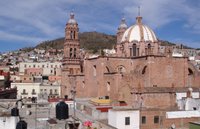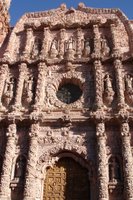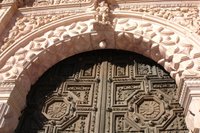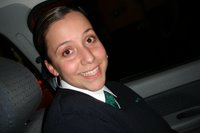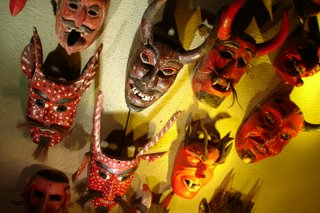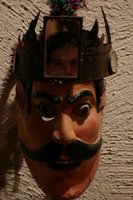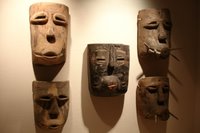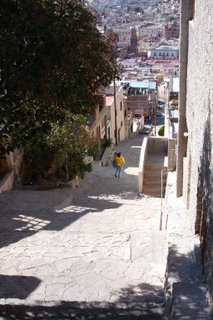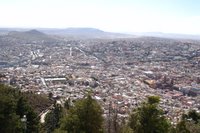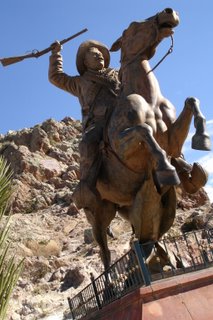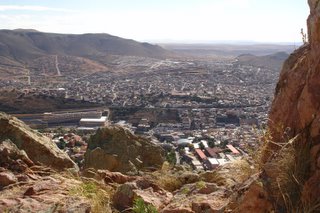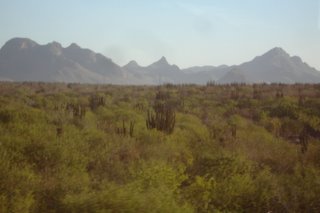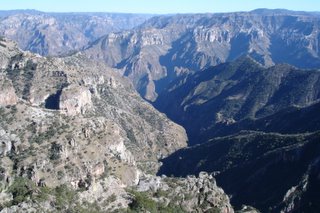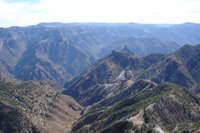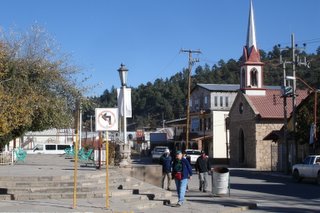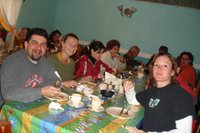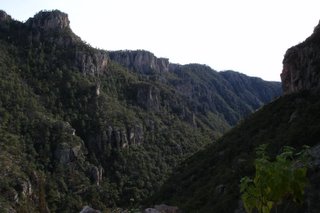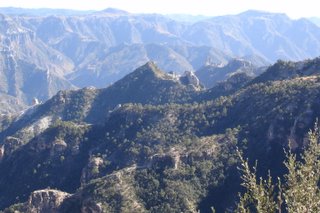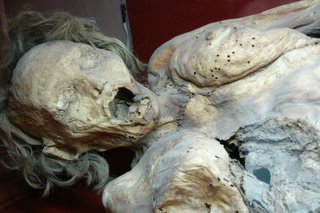 High up on the outskirts of central Guanajuato is Mexico´s strangest tourist attraction - El Museo de las Momias. It`s also one of the most popular if the long lines of wide eyed visitors present on the day I visited are anything to go by.
High up on the outskirts of central Guanajuato is Mexico´s strangest tourist attraction - El Museo de las Momias. It`s also one of the most popular if the long lines of wide eyed visitors present on the day I visited are anything to go by.The Museum houses the remains of over 100 of the city´s citizens exhumed from the local graveyard between 1865 and 1979. Mexican law used to state that if death dues were not paid in full within a few years of your death your body would be dug up from the ground to make space for a wealthier neighbour. When they started doing this in Guanajuato they noticed an odd thing - the bodies were coming back preserved - it seems the ground contains the perfect chemical mix.
Now at this point you might think cremation would be an option, or at the very most a brief scientific investigation before the bodies were disposed. But this being Mexico, with its unique `relationship` with death, someone saw a gap in the market and got to work.
 The bodies were originally stacked alongside each other, the dead heavily pregnant woman alongside what`s supposed to be the world`s smallest mummy, but there were complaints. Shocked tourists (mainly Americans) petitioned everyone from the President to the Pope to tackle this outrage. The upshot is that the bodies are now laid behind flexiglass screens allowing the thousands of visiting schoolkids to press their faces right up against the relatively recent dead.
The bodies were originally stacked alongside each other, the dead heavily pregnant woman alongside what`s supposed to be the world`s smallest mummy, but there were complaints. Shocked tourists (mainly Americans) petitioned everyone from the President to the Pope to tackle this outrage. The upshot is that the bodies are now laid behind flexiglass screens allowing the thousands of visiting schoolkids to press their faces right up against the relatively recent dead.The upgrade also had the beneficial side effect of stopping tourists breaking off the odd finger or toe to take back as a souvenir. We`re talking about fresh levels of sickness here.
It`s a really bizarre experience. The sheer number of corpses is pretty shocking. Perhaps most affecting of all is how the hair remains - not just on skin slowly peeling off skulls, but as small curls working their way up petrified legs - and in many cases covering long dessicated genitals.
Oh yes, there´s no shame here. Not only do the deceased go on show for eternity, but their shrivelled up bits are exposed in their full glory under the installed spotlights and flashes of the countless cameras recording the shame for perusal back at home.
While all this is fascinating for the first fifteen or so minutes it does start to get a bit stuffy and the novelty wears off surprisingly fast - even when the organisers decide to shake things up by pasting up before-pictures of the bodies freshly lying in their coffins for comparison with the after-reality staring back at you.
The weird thing is that once back in the fresh air and bustling streets I started to look at some of the aged, crooked denizens of the city as they shuffled along the historic centre and realised several looked little healthier than their cousins on display nearby.
One more story about the museum before I move on - when I arrived there was a huge queue of Mexicans by the box office which, being a Brit, I naturally joined without question. It was only 20mins later that a member of staff spotted me and pointed out they were waiting to enter as part of a group tour and I could get my ticket straight away at a second till. The irony is that the group was made up of senior students from a nearby Tourism Academy - and not one had thought to point out my obvious error.
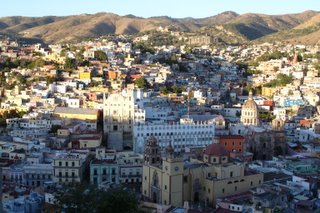 Gunajuato itself is very much a living vibrant city. It houses one of Mexico`s top universities and its students ensure a wide selection of bars, cheap restaurants, internet cafes and live/dance music in the evenings. The city has also started to attract rich American retirees who want to enjoy both the Mexican cheap cost of living and its culture. One couple I spoke to explained they had moved to the city rather than nearby San Miguel Allende because the latter was now overpacked with Republicans. (As a sidenote it`s interesting how US Americans nearly always strongly identify themselves by political affiliation in a way most Europeans never would).
Gunajuato itself is very much a living vibrant city. It houses one of Mexico`s top universities and its students ensure a wide selection of bars, cheap restaurants, internet cafes and live/dance music in the evenings. The city has also started to attract rich American retirees who want to enjoy both the Mexican cheap cost of living and its culture. One couple I spoke to explained they had moved to the city rather than nearby San Miguel Allende because the latter was now overpacked with Republicans. (As a sidenote it`s interesting how US Americans nearly always strongly identify themselves by political affiliation in a way most Europeans never would). I could take a cheap shot at how this fresh wave of immigration will undoubtedly benefit the city`s death trade, but it would be too easy. Instead I`ll simply remark that the city´s funeral parlour looked in good nick and was stacked full of freshly carved coffins when I peeked my head through the door.
I could take a cheap shot at how this fresh wave of immigration will undoubtedly benefit the city`s death trade, but it would be too easy. Instead I`ll simply remark that the city´s funeral parlour looked in good nick and was stacked full of freshly carved coffins when I peeked my head through the door.Actually pretty much all of Guanajuato looked in good order. Much of the reason is that like Zacatecas it houses a thriving silver mining industry. There´s the possibility of visiting the nearby mine - but unlike Zacatecas you can´t go down into the ground and since it`s a few kilometres out I didn´t bother making the trek.
Instead on my first day´s explore I was attracted to the home of another dead man -
 Diego Riviera. Outside Mexico the artist may now be better know as the husband of Frida Kahlo, but here he´s still recognised as the country´s most accomplished artist. Originally he was shunned by the wealthy leaders of Guanajuato because of his communist leanings, but I guess fame has a way of sorting things out.
Diego Riviera. Outside Mexico the artist may now be better know as the husband of Frida Kahlo, but here he´s still recognised as the country´s most accomplished artist. Originally he was shunned by the wealthy leaders of Guanajuato because of his communist leanings, but I guess fame has a way of sorting things out.I´d tried to see his murals in Mexico City and some of his work held in a Zacatecas museum but both attempts had failed as the buildings were closed when I´d arrived.
I knew from the LP that his childhood home housed some of his drawings and paintings, including the above sketch of Frida, as well as others of his lovers. But I didn´t expect the selection to be such a varied mix of styles.
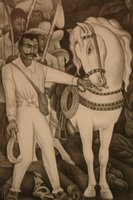

There`s everything from historical detailed drawings to large Picasso-inspired oils, brightly coloured indigenous-styled art, landscapes and small outline sketches of his famous giant murals. Filling up the upper floors of the (very impressive) house I was left in no doubt that he was hugely talented at every mode of art he applied himself to. Or maybe they just don´t display his shit work ;)
 As an added bonus at the top floor of the frankly HUGE house there was an exhibition of photos by Alberto Korda of Che Guevara and Castro including ´that´ picture, which the exhibition modestly described as ´the most famous photo in the world´. What caught my attention is that the original picture wasn´t the close up of Che´s face that we´re so familiar with, but Korda had tried to be arty and frame Che with a second figure. I sneaked a quick picture when the guards weren`t looking and have included it alongside so you can see for yourselves (click to enlarge it).
As an added bonus at the top floor of the frankly HUGE house there was an exhibition of photos by Alberto Korda of Che Guevara and Castro including ´that´ picture, which the exhibition modestly described as ´the most famous photo in the world´. What caught my attention is that the original picture wasn´t the close up of Che´s face that we´re so familiar with, but Korda had tried to be arty and frame Che with a second figure. I sneaked a quick picture when the guards weren`t looking and have included it alongside so you can see for yourselves (click to enlarge it). I spent most of the rest of the first daytime just getting my bearings. The main part historic centre is actually pretty easy to navigate - one main road winds past museums, shops, churches and markets with smaller roads and plazas shooting off hiding numerous bars, cafes and fountains. But venture far beyond and it's easy to get lost in a maze of thin steep alleyways. The free map handed out by the tourist board (on Calle Obregon) isn't much help. It looks very pretty - a tangle of multicoloured strings that faintly resemble a few of the main roads - but doesn't even attempt to tackle the rest of the town. But if you have the time it's well worth letting yourself get lost and then working your way back by spotting the main monuments as they appear through the spaces between the buildings.
I spent most of the rest of the first daytime just getting my bearings. The main part historic centre is actually pretty easy to navigate - one main road winds past museums, shops, churches and markets with smaller roads and plazas shooting off hiding numerous bars, cafes and fountains. But venture far beyond and it's easy to get lost in a maze of thin steep alleyways. The free map handed out by the tourist board (on Calle Obregon) isn't much help. It looks very pretty - a tangle of multicoloured strings that faintly resemble a few of the main roads - but doesn't even attempt to tackle the rest of the town. But if you have the time it's well worth letting yourself get lost and then working your way back by spotting the main monuments as they appear through the spaces between the buildings. One of the weird things for me was seeing the newly placed Christmas decorations sparkle in the sunlight. I'm used to seeing the festive frills dripping with rainwater, only glinting as they reflect streetlamp light or car headlights. All that glitter in the bright warm sunlight somehow just seemed wrong.
One of the weird things for me was seeing the newly placed Christmas decorations sparkle in the sunlight. I'm used to seeing the festive frills dripping with rainwater, only glinting as they reflect streetlamp light or car headlights. All that glitter in the bright warm sunlight somehow just seemed wrong. One more strange thing I never got to the root of was a couple of guys who would wander up and down the streets ringing a huge bell. No-one seemed to pay them any attention and there really didn't seem to be any purpose to it. Every now and then they'd stop, have a sit down and a rest, and then start their ringing wandering again. If you know what that was all about please enlighten me.
By about 6pm it was time to cut short my own wanderings. The city centre's water supply had been temporarily suspended for maintenance work and after my long overnight journey I was quite keen to grab a shower before the evening. The plan was also to try to meet others at Hostalito Guanajuato where I was staying, but for once my luck seems to have run out. There was no-one else downstairs in the reception area and bizarrely the hostel's advertised terrace area was only accessible through one of the locked dorm rooms.
 I didn't have time to hang around hoping to meet other travellers anyway as I'd earlier bought a ticket to see a flamenco show at Teatro Juarez. The theatre is a spectacle itself. Dating back to the early 20th century it's imposing entrance gives way to a spacious lobby filled with stained glass panels and gleaming floors. The walls of the theatre itself are covered with complicated carved Moorish patterns painted a deep red and gold. I got chatting to a softly spoken Chinese American woman who sat next to me and we easily filled the time before the performance talking about the intricate and no doubt costly decorations. The benefits of living in a silver city again were obvious.
I didn't have time to hang around hoping to meet other travellers anyway as I'd earlier bought a ticket to see a flamenco show at Teatro Juarez. The theatre is a spectacle itself. Dating back to the early 20th century it's imposing entrance gives way to a spacious lobby filled with stained glass panels and gleaming floors. The walls of the theatre itself are covered with complicated carved Moorish patterns painted a deep red and gold. I got chatting to a softly spoken Chinese American woman who sat next to me and we easily filled the time before the performance talking about the intricate and no doubt costly decorations. The benefits of living in a silver city again were obvious.I'd guess the majority of the audience were foreigners - it was probably the first time I'd been surrounded by so non-Mexicans since arriving. So it's hard to know whether the barrage of flash photographs that accompanied each costume change is normally acceptable in Mexican theatre. Certainly it seemed allowed and didn't faze the musicians and dancers. Though I've seen better flamenco in Sevilla the company's standard was high - especially the principle dancer/choreographer who stole every scene she was in.
By this point the streets were thronging with people attracted by the variety of Saturday nightlife. Normally I'd have been attracted to one of the nightclubs, but was feeling in a mellow mood after the show and instead opted for a trova bar. Trova is basically a singer-songwriter music, often one man (and it is usually a guy) a guitar and a songbook. Think early Billy Joel, Damien Rice or even a laidback Bob Dylan. This place was packed both with young couples and older groups chilling out to songs by Silvio Rodriguez, Pablo Milanes and others over the candlelight. Very cool - and I found myself staying for one more song, then one more and another before I was finally left with just enough energy to stagger the 10-15 minutes back to my bed.
 One of the joys of Guanajauto is it is so damned photographable. I'd originally planned to spend my second day taking a day tour to nearby San Miguel de Allende and Dolores de Hidalgo but changed my mind en route to the pick up point preferring to spend the day snapping coloured monuments framed by narrow alleys and playing with the exposure settings on my camera to capture the wide array of architecture.
One of the joys of Guanajauto is it is so damned photographable. I'd originally planned to spend my second day taking a day tour to nearby San Miguel de Allende and Dolores de Hidalgo but changed my mind en route to the pick up point preferring to spend the day snapping coloured monuments framed by narrow alleys and playing with the exposure settings on my camera to capture the wide array of architecture.Throughout the day I had the nagging sensation that Guanajuato reminded me of somewhere else. Finally I twigged - it's Mexico's sunnier sister city to historic Edinburgh. If you've visited Scotland and are scratching your head hang with me a second here and I''ll try to explain...
 A large river originally flowed through the middle of Guanajuato, but was diverted in 1905. The water's path has now been converted into a large underground roadway off which several tunnels have been built to keep traffic away from the mainly pedestrianised city centre. This means the city effectively operates on two levels with stairways punctuating pavements allowing its citizens to descend into the gloomy smelly depths. The effect is much like Edinburgh's multi-layered Old Town leaving both cities a pleasure to walk round, but a nightmare to drive.
A large river originally flowed through the middle of Guanajuato, but was diverted in 1905. The water's path has now been converted into a large underground roadway off which several tunnels have been built to keep traffic away from the mainly pedestrianised city centre. This means the city effectively operates on two levels with stairways punctuating pavements allowing its citizens to descend into the gloomy smelly depths. The effect is much like Edinburgh's multi-layered Old Town leaving both cities a pleasure to walk round, but a nightmare to drive.  They also both seem to have the impossible feature of having more up hills than down hills. But Guanajuato has a trick up it's sleeve - or at least up its steepest hillside: A tiny Funicular which carries grateful passengers up to crazily steep incline. I shared the cabin with a group of touring school children. Looking down at the coiled metal cable dragging us shuddering to the top the teacher kept his class amused by speculating about the chances of it snapping under our weight. The operator's stoneyfaced look was the only reassurance this wasn't a headline waiting to be published.
They also both seem to have the impossible feature of having more up hills than down hills. But Guanajuato has a trick up it's sleeve - or at least up its steepest hillside: A tiny Funicular which carries grateful passengers up to crazily steep incline. I shared the cabin with a group of touring school children. Looking down at the coiled metal cable dragging us shuddering to the top the teacher kept his class amused by speculating about the chances of it snapping under our weight. The operator's stoneyfaced look was the only reassurance this wasn't a headline waiting to be published. The view from the top was spectacular - and is shown at the top of the entry. But it vies for attention with another dead man who dominates the city - El Pipla (visible in the photo in the top right corner if you click and expand it). The story goes that in 1810, during the Mexican War of Independence, his actions gave the rebel army its first victory. The Spanish had holed up in the city's grain storehouse and seemed to be in good position to hold out against the 20,000 Mexicans until help arrived. Bu the rebel leader, Miguel Hidalgo, had a plan. He ordered a young miner (El Pipla) to tie a huge stone slab to his back and use it as a shield against the Spanish bullets. El Pipla was then able to walk up to the store's gates, set them alight and cook the Spaniards inside. Legend says he lived to a ripe old age - which is more than can be said for Hidalgo and the other three rebel leaders. They were captured a year later and their severed heads were left rotting on display at the site for a decade.
The view from the top was spectacular - and is shown at the top of the entry. But it vies for attention with another dead man who dominates the city - El Pipla (visible in the photo in the top right corner if you click and expand it). The story goes that in 1810, during the Mexican War of Independence, his actions gave the rebel army its first victory. The Spanish had holed up in the city's grain storehouse and seemed to be in good position to hold out against the 20,000 Mexicans until help arrived. Bu the rebel leader, Miguel Hidalgo, had a plan. He ordered a young miner (El Pipla) to tie a huge stone slab to his back and use it as a shield against the Spanish bullets. El Pipla was then able to walk up to the store's gates, set them alight and cook the Spaniards inside. Legend says he lived to a ripe old age - which is more than can be said for Hidalgo and the other three rebel leaders. They were captured a year later and their severed heads were left rotting on display at the site for a decade.These days you can walk up to the top of the statue if you pay a couple of pesos. But to be honest the view is little different from the one from the viewing platform at its base.


One other dead guy haunts the city - Cervantes and in particular his creation Don Quixote. Every year the city holds the 2-3 week long Festival Internacional Cervantino at the end of October which is widely regarded as one of the cultural highlights of Latin America. Musicians, actors, artists and dancers come from all over the world to perform and accommodation becomes near impossible to find and significantly more expensive. Just like Edinburgh's own summer festival (see another link!).
But even over the other 50-odd weeks of the year it's hard to avoid the Spanish author's influence. A huge bronze statue dominates a coutyard at one end of the historic centre, there the wonderful (and free) Museo Iconografico Del Qiojote containing the mad knight and his companion Sancho Panza depicted in paint, scultpure, glass and china by a dazzling range of artists. Plazas, bars and shops are named after Cervantes and the local university bestows its own Nobel prize to scholars who have specialised in his works - no prizes for guessing what the medal is called. In the evenings as the locals gather to listen to musicians playing music round the Jardin de la Union painters display their newly painted fantasies of Quioxte and Panza wandering through Guanajuato. The link between the city, the author and his character may only date back about 55 years but it's hard to think of a place so entwined with literary figures. All the more strange when you remember that Mexican nationalism is often in part based on a rejection of Spanish roots.
More details about the festivall can be found at:
 So what else is worth doing in town? Well the Mercado Hidalgo is the big draw if you want to see an old style indoor Mexican market at work. Small food stalls offer super fresh lunches, clothes are sold on the cheap and there's more choice and value available than Walmart could offer in their dreams. Just outside is the place to pick up CDs and DVDs with photocopied covers and discs of dubious origin - if they jump when played don't even dream of sending them back to the manufacturer. And as can be seen above, there's every flavour of sauce available so long as you're looking for chilli (sorry - couldn't resist).
So what else is worth doing in town? Well the Mercado Hidalgo is the big draw if you want to see an old style indoor Mexican market at work. Small food stalls offer super fresh lunches, clothes are sold on the cheap and there's more choice and value available than Walmart could offer in their dreams. Just outside is the place to pick up CDs and DVDs with photocopied covers and discs of dubious origin - if they jump when played don't even dream of sending them back to the manufacturer. And as can be seen above, there's every flavour of sauce available so long as you're looking for chilli (sorry - couldn't resist).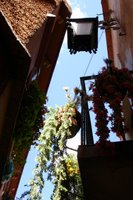 A five minute walk away, just off Plazuela de Los Angeles, Callejon del Beso is also worth a quick visit. Undoubtedly the narrowest walkway I've ever squeezed through, the Alley of the Kiss is famous for the balconies above which almost touch each other. The story goes that centuries ago Doña Carmen, the daughter of a rich but violent man lived in one of the houses. She fell in love with a local lad named Don Luis who courted her by offering her holy water from the local church - what a smoothie. Anyway the dad found out and flew into a rage - threatening to send Carmen to a convent in Spain and locked her up in her room. When Luis found out he bought the house opposite for a small fortune and continued to court Carmen over the balconies which were narrow enough for the two to steal illicit embraces. This being Mexico the story couldn't have a happy ending - the father discovered the deception and stormed into Carmen's room where he plunged a dagger into his unfaithful daughter's heart. She died. Luis was so shocked he kissed the lifeless hand of his love and then killed himself. So Mexico's very own Romeo and Juliet and more dead people to add to the city's bulging list of legends.
A five minute walk away, just off Plazuela de Los Angeles, Callejon del Beso is also worth a quick visit. Undoubtedly the narrowest walkway I've ever squeezed through, the Alley of the Kiss is famous for the balconies above which almost touch each other. The story goes that centuries ago Doña Carmen, the daughter of a rich but violent man lived in one of the houses. She fell in love with a local lad named Don Luis who courted her by offering her holy water from the local church - what a smoothie. Anyway the dad found out and flew into a rage - threatening to send Carmen to a convent in Spain and locked her up in her room. When Luis found out he bought the house opposite for a small fortune and continued to court Carmen over the balconies which were narrow enough for the two to steal illicit embraces. This being Mexico the story couldn't have a happy ending - the father discovered the deception and stormed into Carmen's room where he plunged a dagger into his unfaithful daughter's heart. She died. Luis was so shocked he kissed the lifeless hand of his love and then killed himself. So Mexico's very own Romeo and Juliet and more dead people to add to the city's bulging list of legends.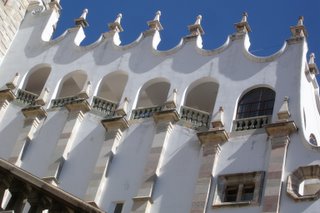 For a place I stayed such a short time there's been a lot to write and remember about Guanajuato. In a way not meeting another group of friends made it easier to pack so much in and use most of the afternoon of my last day to update the blog. Sunday evening was a big contrast to Saturday with many bars closed and the streets very quiet. A very bad trova singer was playing in La Oreja de Van Gogh bar so I came back early to the hostel to make use of the free high speed internet.
For a place I stayed such a short time there's been a lot to write and remember about Guanajuato. In a way not meeting another group of friends made it easier to pack so much in and use most of the afternoon of my last day to update the blog. Sunday evening was a big contrast to Saturday with many bars closed and the streets very quiet. A very bad trova singer was playing in La Oreja de Van Gogh bar so I came back early to the hostel to make use of the free high speed internet. For anyone considering staying at the hostel it is fairly close to the centre, has a big bar and kitchen area and very friendly staff. My private room was large and clean although there wasn't the option of an ensuite bathroom. Had there been a few more travellers it would have been a perfect base - guess I just picked the downtime.
 I arrived in Guanajuato tired and after an initial wander was ready to be disappointed after the pleasures of Zacatecas. But the city really grew on me, both through its colourful tales and its rich visual wealth. Of all the places I visited in Mexico it's here I most wished I had a proper large lens SLR camera. If you're passing through this way it's well worth sparing at least a couple of days and a few hundred megabytes of memory card.
I arrived in Guanajuato tired and after an initial wander was ready to be disappointed after the pleasures of Zacatecas. But the city really grew on me, both through its colourful tales and its rich visual wealth. Of all the places I visited in Mexico it's here I most wished I had a proper large lens SLR camera. If you're passing through this way it's well worth sparing at least a couple of days and a few hundred megabytes of memory card. Guanajuato - it's dead good.

